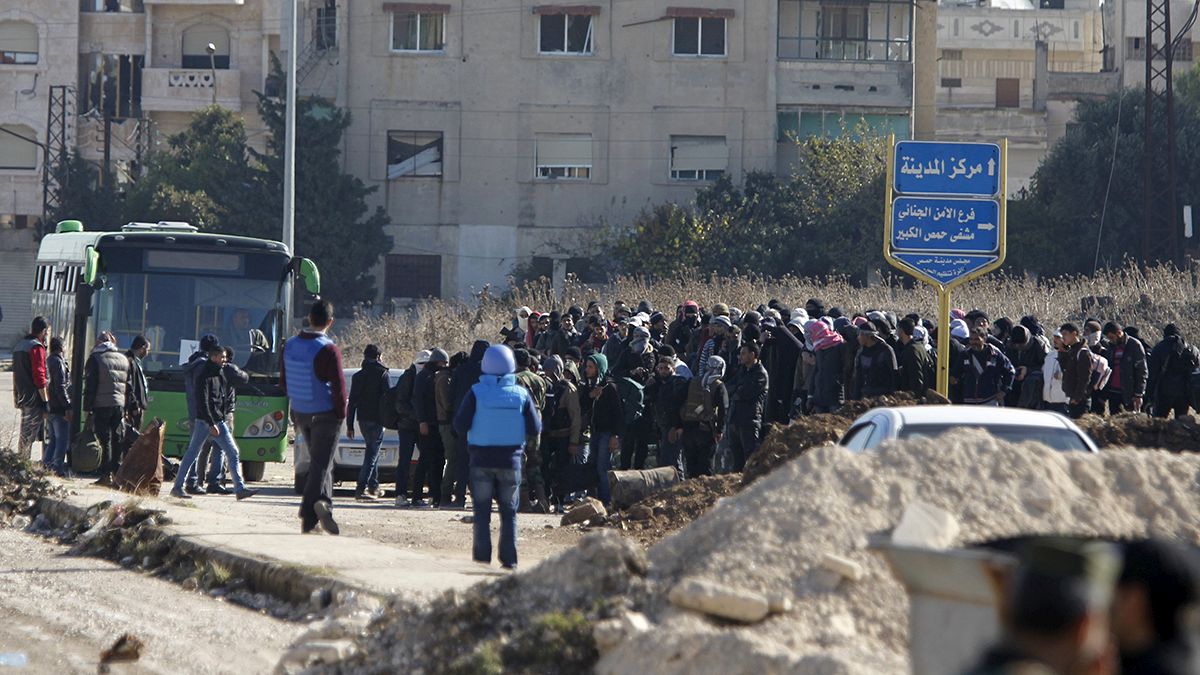Buses carrying insurgents leave the Syrian city of Homs Part of rare local ceasefire deal Priority given to women, children, seriously wounded
- Buses carrying insurgents leave the Syrian city of Homs
- Part of rare local ceasefire deal
- Priority given to women, children, seriously wounded
- 300 fighters, 400 relatives have left says Homs governor
- Described as “militants who reject deal”
- We may see more ceasefires – Obama
What is happening in Homs?
WATCH: #Militants Evacuate #Homs under Government Deal – See more at: https://t.co/tN5b0YsQ9vpic.twitter.com/D7mrD0f1lh
— #Alalam (@AlalamChannel) December 9, 2015
Rebels evacuate #Homs under #Syria ceasefire deal https://t.co/MRv8qVo588pic.twitter.com/nlNHwYIGdI
— al-Araby al-Jadeed (@alaraby_en) December 9, 2015
Eyewitnesses have counted 15 buses full of people leaving Waer, the last rebel-held area of the city.
It is part of the terms of a rare local truce agreement that has been signed in an attempt to shore up government control over the city.
Priority is being given to women, children, the elderly and the seriously wounded.
Homs governor Talal al-Barazi told reporters 300 rebel fighters have also left, along with 400 members of their families.
#Syrian people, who didn't accept #ceasefire deal, say good bye to their relatives in #Homs, #Syria#AApic.twitter.com/wQWSenC14F
— Anadolu Images (@anadoluimages) December 9, 2015
He described the rebels as “militants who reject the agreement” and said they “took light arms with them”.
Why Homs?
Homs was the cradle of the uprising against Syrian President Bashar al-Assad.
It is the third-largest city in Syria.
The ceasefire agreement follows a major Syrian army ground offensive to the north of the city, backed by Russian air strikes.
Where will they go?
The rebel fighters and their families are being moved to insurgent-held areas in the north-west of the country, near the Turkish border.
The governor says the buses will make a stop in Hama province where those who wish to can disembark.
They will then continue to Idlib province, the insurgent stronghold which also shelters the al Qaeda-linked Nusra Front.
Who is supervising the operation?
The United Nations is presiding over the implementation of the deal.
It was agreed directly between the two sides.
#Syrian rebels start pulling out of #Homs, as part of a deal with gov. forces.
Evacuation process was presided by UN
https://t.co/tS4nUOeCT2— kicca sinai (@kiccasinai) December 9, 2015
Humanitarian aid reached the Waer district of Homs last week under the terms of the truce.
Ceasefires in Syria – what you need to know
US President Barack Obama says there may be more local ceasefire deals in Syria, freeing opposition groups from Russian air strikes.
In late September, Iran and Turkey helped bring about ceasefires in the town of Zabadani near the Lebanese border and two villages in the northwestern province of Idlib.
A previous truce in Homs in 2014 allowed insurgents to withdraw from the old city, while Waer and other districts remained in the hands of opposition fighters.
Diplomats say the latest Homs ceasefire is an improvement on the last one, as it has been negotiated directly between Syrians, rather than involving outside states.
There are unconfirmed reports of 40-50 similar deals on the table waiting to be discussed.
Some diplomats think local ceasefires may be the best way to bring peace to the conflict-torn country, allowing stakeholders to concentrate on the conflict with ISIL.
